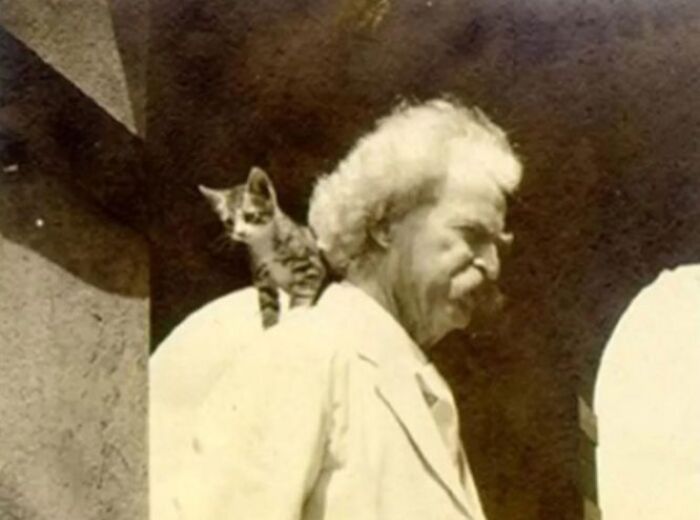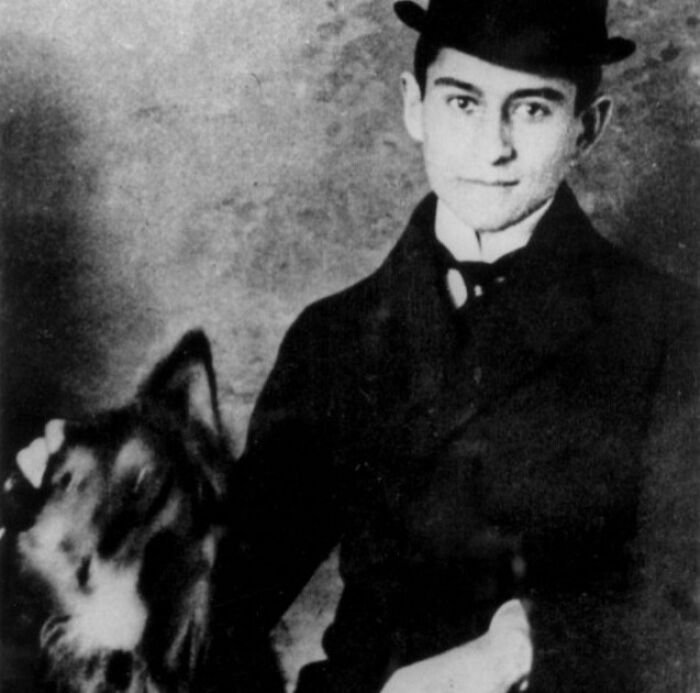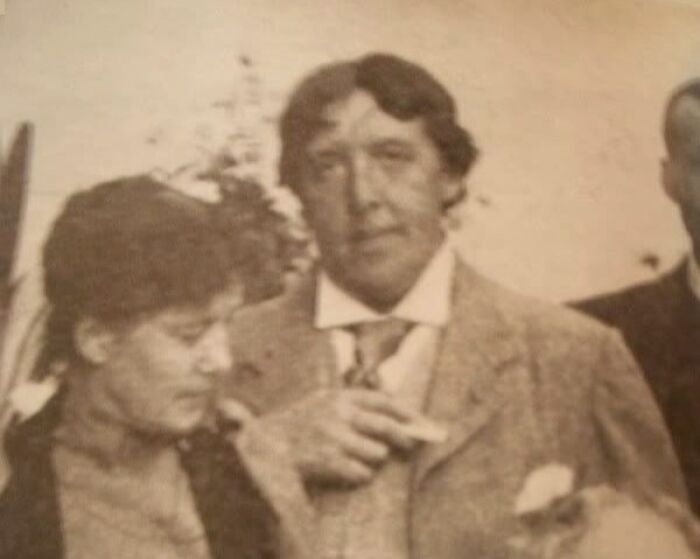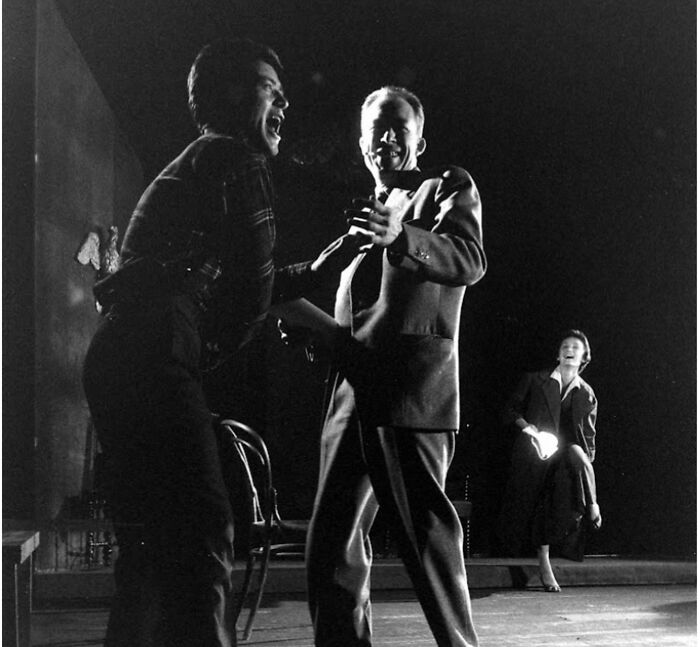When we hear the names of writers, we usually think of their work first and not of the people who wrote them. But it doesn't change the fact that these authors existed and had full-blown lives that impacted their work. And so, sometimes it can be very interesting to think about who the people were deep down who wrote the famous books or other texts.
Threads like this one shared on X let us catch at least a small glimpse into that. After all, seeing an uncommon photo of a writer can make a reader grasp their work in a light they might not have been able to before.
More info: X
This post may include affiliate links.
J.R.R Tolkien In His Study With His Own Hand-Drawn Map Of Middle Earth
Mark Twain With A Cat
Franz Kafka With His Dog
We all know the saying “Art is subjective.” It’s created with the subjective author’s vision, influenced by their personality and experiences. The art consumers add another layer of subjectivity by understanding it through their characteristics and experiences.
Literature is no exception to this rule. While general themes can be understood from written texts, certain passages may be interpreted differently by different people.
One of the things that might influence how people understand a text is the way they perceive the person who wrote it. Some people might love or hate certain writers depending on the information they learn about them or the way they fit (or don't fit) their values and expectations of their actions and writing.
Portrait Of Edgar Allan Poe, Believed To Be The Earliest Known Photograph Of Him
A Daguerreotype Of A Young Frederick Douglass
Rare Portrait Of Virginia Woolf
As an example, we can take the currently famous writer Colleen Hoover. The author who skyrocketed due to BookTok has many fans that love her writing, which helped her to sell a very high number of book copies.
At the same time, some people wholeheartedly dislike her. Some accuse her of romanticizing abusive relationships and overshadowing important topics in her books with smut scenes. Others dislike her because of her controversies. For instance, trying to silence a girl who came forward about her son abusing her. These people refuse to read the author’s books because knowing all this stuff about her, they can’t separate the art from the artist.
Oscar Wilde Attending A Garden Party
The biopic sucked but casting Stephen Fry was absolutely perfect. The resemblance is bang on.
Rare Daguerreotype Of Charles Dickens
YT: How was it made? The Daguerreotype | V&A https://www.youtube.com/watch?v=DAPgdo5H7ZY
Alexander Solzhenitsyn On The Day Of His Liberation After 8 Years In The Gulag
But information isn’t the only thing that can influence the reader’s perception of the author and their work. A simple photograph of the writer can also have a lot of influence. So, Bored Panda got in touch with Loreta, an expert teacher of the Lithuanian language, who agreed that pictures can influence the way texts are perceived.
She also said that in her opinion, it can be hard for readers to enjoy a piece of work when they don’t know anything about its context. And while sometimes the context can be found by researching the time period a book is written in or about, other times even a single photograph of the author can do the job.
Loreta voiced that “The photos can give an idea about the condition the author was writing or what kind of person they were and how it all influenced what they wrote.”
Ernest Hemingway With His Chauffeur Adamo Simon
C. S. Lewis With A Pipe
The Only Color Picture Of Leo Tolstoy
Yet, the social or cultural context isn’t the only thing that an author’s photo can suggest. They help a reader to comprehend that the person who wrote the text is (or was) a real human being and not only a name on a book cover. As Loreta said, “Understanding the personality behind the text helps the readers to connect with it more. And a connection with the text always makes it at least a little bit easier to enjoy it.”
At the same time, she noted that relying solely on the author's photo to influence text comprehension is a bad idea. Sometimes such influence can go too far and skew a proper understanding of the text.
For example, if the person perceives an author from their photo as a very serious and intellectual person, they might start thinking that their text is overly complicated. Or if they see the writer as a simple, down-to-earth person, they might think that the text and its themes are supposed to be the same way.
46-Year-Old Charles Darwin
The The First Known Picture Of Friedrich Nietzsche
Last Photo Of Fyodor Dostoevsky While Alive
That’s why critical thinking is so important. You shouldn't let one mere photo fully influence how you perceive an entire body of text. Loreta said, “Sometimes an author can look one way, but it doesn’t mean their work reflects that.” She also added that “People are way more complex than their appearance, and so fully judging them and their work according to it isn’t the right thing.”
Basically, while art, including books and photography, is subjective, we need to learn to find a line of objectivity within it. So, while looking through these rare photos of famous authors, remember that while they show unseen parts of them, they also capture just a fragment of their lives.
Which photo of these authors, in your opinion, best correlates with their work? Share with us in the comments.
William Edward Burghardt Du Bois At Age 4
A Rare Portrait Of F. Scott Fitzgerald
Portrait Of A Young Sigmund Freud
Rare Picture Of John Steinbeck
Jorge Luis Borges Poses With Bread Basket On His Head
Albert Camus Dancing
“There is only one really serious philosophical problem, and that is suicide,” So let’s all dance!
Portrait Of Karl Marx
He specifically wanted that drape in the photo. It’s made of dialectical material
Anna Julia Cooper Graduating
Young Gilbert Keith Chesterton
Why does the poll suggest Orwell's choice? I didn't see his photo there ?? 😕 ??
What I learned from this is daguerreotypes are friggin’ awesome, they look much more real than most photos.
Developed in 1848, photographs taken with glass plate negatives are so clear in detail they are amazing. Only problem was the plates were so fragile, they had to be carefully stored and protected to survive for posterity, The history of photography is astounding.
Load More Replies...Why does the poll suggest Orwell's choice? I didn't see his photo there ?? 😕 ??
What I learned from this is daguerreotypes are friggin’ awesome, they look much more real than most photos.
Developed in 1848, photographs taken with glass plate negatives are so clear in detail they are amazing. Only problem was the plates were so fragile, they had to be carefully stored and protected to survive for posterity, The history of photography is astounding.
Load More Replies...
 Dark Mode
Dark Mode 

 No fees, cancel anytime
No fees, cancel anytime 
























































